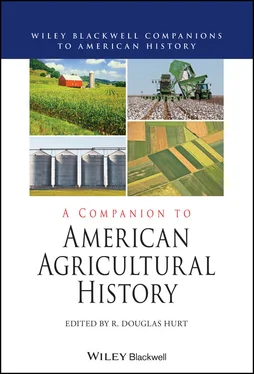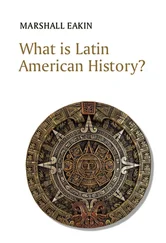Across the North American continent, Indigenous food producers raised enough crops to sustain densely settled communities, complex political and ritual institutions, long-distance trading networks, and magnificent art and architecture. Farmers in both the Southwest and eastern North America bred diverse landraces of maize and other crops adapted to local climatic and edaphic conditions, with relevant genetic legacies for today’s agricultural economy. Early observers from the Old World may not have been impressed by the relatively simple tools, cooperative methods of organizing labor, small-scale water control mechanisms, non-plow tilling, unfamiliar crops, and polyculture strategies, but Native North American agricultural systems stand as models of energy-efficient food production that might serve to ensure the survival of future generations.
Europeans were fascinated by the animals and plants—including new crops—that they encountered in the Americas. Maize often rose to the forefront of their interests due to its primacy in the diets of many Indigenous American farmers and its availability as a source of calories to be exploited for the survival of exploratory expeditions, trading parties, and colonizing settlers. Early observations of Native North American farmers by Spanish, French, and English invaders and explorers during the sixteenth through eighteenth centuries established a baseline inventory of maize-beans-squash-sunflower production along the Atlantic seaboard and into the interior of the Eastern Woodlands. Arthur C. Parker (1910), John R. Swanton (1911, 1946), Charles Hudson (1976), and Bruce G. Trigger, Swagerty, and Washburn (1996) provide good summaries of early ethnographic accounts, many of which included descriptions of crops and the foods prepared from them.
Caches of ancient seeds and maize found buried in rockshelters and caves across the continent stimulated interest in pre-Columbian North American agriculture on the part of scholarly minded nineteenth and early twentieth-century US residents. In 1876, E.B. Andrews excavated a large cache of uncharred seeds found near a prehistoric burial in Ash Cave, Ohio. Andrews (1877) sent the seeds to Asa Gray at Harvard, who identified them as Chenopodium album . This is considered the earliest published report of the ancient lost crop now classified as C. berlandieri ssp. jonesianum (Smith 1992). A chapter by Yarnell (1994) in the volume Agricultural Origins and Developments in the Midcontinent provides a thorough summary of early research into chenopod and other crops constituting the pre-maize Eastern Agricultural Complex. More recent overviews can be found in books by Gremillion (2018) and Fritz (2019), with the former taking a behavioral ecological perspective on food production across the North American continent, and the latter focusing on the rise of agricultural societies in the central Mississippi River valley.
Because several Eastern Agricultural Complex crops fell out of cultivation well before the nineteenth century, their domesticated statuses and their former economic significance to Indigenous farmers went unrecognized for decades. The road to global acceptance of eastern North America as an independent center of plant domestication was slow, contingent upon maturation of botany as a science in the Americas, invention of radiocarbon dating in the late 1940s and accelerator mass spectrometry (AMS) in the 1970s, implementation of flotation recovery as standard archaeological procedure starting in the 1960s, use of scanning electron microscopy in the 1980s, and most recently, the wonders of molecular biology including analysis of both modern and ancient DNA (Blake 1939; Watson 1976; Johannessen 1984; Asch and Asch 1985; King 1985; Decker 1988; Fritz and Smith 1988; Smith 1998, 2011; Kistler and Shapiro 2011; Fritz et al. 2017; Mueller 2017).
The spread of maize into eastern North America and the development of maize-based farming societies are covered by chapters in volumes edited by Hart (1999, 2008), Minnis (2003), Scarry (1993), Smith (2011), and Staller, Tykot, and Benz (2006). VanDerwarker, Bardolph, and Scarry (2017) provide an excellent summary of the regional variability characterizing late pre-Contact Mississippian agriculture.
Euro-Americans began digging into Southwestern cliff dwellings and open-air Ancestral Pueblo sites during the late 1800s, finding caches of maize and seeds, some in the original baskets, bags, and pots in which they had been stored. Ancient maize was among the material excavated by the Wetherill Brothers from dry sites in southwestern Colorado and southeastern Utah, exhibited at the Columbian World Exhibition in Chicago in 1893. John Harshberger (1896) described remains from Mancos Canyon in his lecture “The Purposes of Ethno-Botany,” considered the earliest application of archaeobotany in that region. Chapters by Ford (2004) and Minnis (2004) include overviews of early research into pre-Contact farming in the Southwest.
Early decades of the twentieth century brought university-trained archaeologists to the Southwest. Dendrochronology made it possible to assign relative ages and even to know the calendar dates of some occupations in the Four Corners region of the Colorado Plateau (Cordell and McBrinn 2012). Specialists including Castetter and Bell (1942), Cutler (1952), Kaplan (1956), and Jones and Fonner (1954) contributed major studies of plant remains, with emphases on maize, beans, and squashes. By the 1950s, radiocarbon dating transformed archaeology in the Southwest and around the world, vastly improving our ability to understand when, how, and why ancient peoples made the transition from foraging to farming, how their agricultural economies developed through time, and how they varied across space.
Numerous volumes and journal articles have been devoted to these questions. Books by Wills (1988), Matson (1991), and Roth (2016) present broad overviews including explanatory models and comprehensive data. Several chapters in the volume Prehistoric Food Production in North America , edited by Ford (1985), are devoted to agricultural beginnings in the Southwest. Articles and chapters by Wills (1992), Mabry (2005), Mabry and Doolittle (2008), Vierra and Ford (2007), Diehl and Waters (2006), and Hard et al. (2008) track developments during the final years of the twentieth century and first decade of the twenty-first. The textbook Archaeology of the Southwest by Cordell and McBrinn (2012) includes good discussions of both early and later agricultural systems. Readers should be alert to an often-changing kaleidoscope of dates and site names, as both newly excavated and long-curated specimens were submitted for direct AMS dating, sometimes confirming the antiquity of maize and sometimes disconfirming the age of remains that had not been directly dated previously.
Flotation recovery revolutionized the study of early agriculture in the Southwest as it did in eastern North America, with small fragments of cultigens from open-air sites expanding the geographical range and sometimes the temporal span of early agriculture. Massive cultural resource management (CRM) projects in southern Arizona revealed astonishing evidence for deeply buried farming settlements with irrigation ditches, houses, and storage pits in which maize was ubiquitous, dating to at least 4100 bp. Recent overviews can be found in Roth (2016), Gremillion (2018), Hanselka (2017), and Vint (2017). New evidence is quickly surfacing, and interpretations are constantly evolving in this dynamic region.
Unlike the Southwest or Eastern Woodlands, the Northwest Coast lacks dry rockshelters routinely used for food storage. Inferences for deep-time production of starchy roots, tubers, and bulbs are often based on ethnobotanical studies of traditional First Nations peoples (Turner, Ignace, and Ignace 2000; Deur and Turner ed. 2005; Lepofsky and Lertzman 2008; Turner 2014). These are combined with archaeological surveys and excavations of features such as earth ovens, estuarine rock terraces, and anthropogenic prairies (Peacock and Turner 2000; Weiser and Lepofsky 2009; Lepofsky et al. 2015). Researchers will undoubtedly continue to find new evidence for ancient cultivation of food plants and management of landscapes in ways that made possible the social complexity and high population density of Pacific Northwest societies. Future conservation and restoration projects, along with efforts to enhance local food security, depend on recognizing and understanding the long history of human food production here and across the North American continent.
Читать дальше











